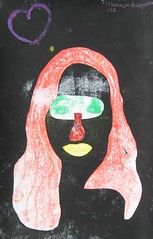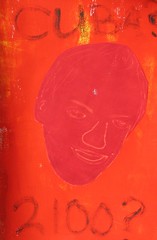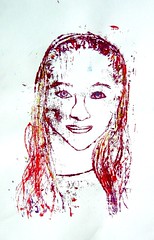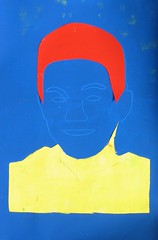A question
I got a mail from Dan Willingham, in which he formulated a very interesting question: "Do you believe that students can achieve expertise more rapidly than they could, say 50 years ago?" The mail referred to my last post in which I wryly commented on some aspects of his book "Why Students Don't Like School." Fortunately Daniel Willingham doesn't ask for scientific research, he only asks about my beliefs. I'm not a scientist, I am just a humble teacher of art in the trenches of Dutch education. So my answer is based on common sense (I hope) and on years of experience in the classroom.
Stonehenge and computers
I see no reason to believe that the human brain has evolved significantly since the neolithic period. The same brain that erected the large stones at Stonehenge builds computers now. But the environment in which the human brain starts thinking during childhood has changed thoroughly. So it is conceivable that learning may have speeded up over the last hundreds of years. After all this is what formal education at school tries to achieve. I can come up with two classroom experiences that may possibly falsify Willingham's concept of the "ten years and ten thousand hours to become an expert"
Perspective
Every year I tell my third form students that they perform an amazing feat. Within about 6 lessons of 100 minutes they grasp the basics of linear perspective and show these insight knowledge in their drawings. It can clearly be seen in paintings of the fifteenth and sixteenth century that this was a very difficult concept for professionals at that juncture, even after Leon Battista Alberti had set out the technique in his treatise "Della Pittura" (1436). Apparently to professional artists the mathematical trick didn't always relate to their perception of the visual world.
Ucello painted the fallen lances precisely towards the vanishing point in the centre of the painting. He grappled with the concept of the depth in the picture plane and had to stick to a mathematical scheme in stead of rendering realistically the utter hassle of a medieval battle.
The forms of the parapet in the painting on the left show clearly that Veronese had mastered perspective in drawing complex mathematical shapes. But he failed to envisage a realistic image of the dog perching on the banister as seen from below. To our modern eyes it is clear that the poor animal will fall down instantaneously.
So it seems that modern children learn a basic drawing technique faster than the medieval painter. However, we must bear in mind that the modern child has been exposed to images which depict the world according to the laws of perspective to an extent that the fifteenth century painter could not have dreamt of. Fifteen year old students have been pummelled by photographs and screen images on a daily basis for over ten years, which is the time frame Daniel Willingham sets for becoming an expert. The students have become experts in reading perspective in realistic images. So it is not amazing that they master producing correct perspective with pencil and ruler within a couple of lessons, they immediately sense something wrong when making a mistake. Albeit, drawing a dog on a high parapet as seen from below will pose as much a problem to them as it did to Veronese. Over the years I have had only a couple of students that could draw such a thing, and these kids were all self trained artists.
So it is a delusion to think that students learn faster now than five hundred years ago when mastering perspective.

Modern Art
My last post, which triggered Willingham's question, dealt with expert decisions students made while performing a task in the art room. I will not budge on this. My students expertly chose colours, shapes and techniques while making a self portrait and their work can be compared with works done by unquestioned masters of modern art. The picture on the right combines five works done by students and four works by famous artists (Francesco Clemente, Andy Warhol, Francis Bacon, Pablo Picasso).
The students deliberately applied techniques that are widely used in modern art to convey expression in a portrait: for example distortion of shape, abstraction by leaving out details, non-realistic colouring and so on. What's more, they used them all differently thereby showing that their choices were not the result of some prescription given to them by their teacher. I trusted them to explore their own ingenuity and so they did.
Craft versus Creativity
There is a meaningful difference between the two cases I am discussing. Learning perspective aims at the production of a realistic image. Until the end of the 19th century perspective was an indispensable tool of the painter. Within the context of modern art this tool may be applied but there is no need for an artist to learn perspective any more because modern art not necessarily aims at production of realistic images any more. Conversely many works of modern art are autonomous, they may refer to the world around the canvass or sculpture, but not by imitating shapes, colours and space in a mechanical way.
The Child Artist
Modern artists have often been inspired by the creativity with which young children depict their world playfully and spontaneously. I don't buy the argument however that children do not have to learn art. The children's spontaneity in making art mostly stops somewhere after early childhood if they are not encouraged to go on. School education can perpetuate their development, thereby fostering their inchoate artistic talents.
Given the fact that most children in our culture start to draw and paint at the age of two or three my students have had more than ten years of experience. I can clearly see though in the classroom that the amount of time spent on artistic productivity varies enormously between my students. The so called "gifted" indeed spent a lot of time on art voluntarily because the activity filled them with joy in which they were not disappointed by the feedback of their environment. Those students bring their own colour schemes and subject preferences into my class room. To others the act of making art has become all but meaningless, they do not feel confident at all while handling a brush or a gouge. A couple of hours weekly in a school's art room is not enough for these students to keep the engine running.
The Self Portrait
The task to make a representation of the self revved up the gusto of even these students and enticed them to make expert decisions. In fact I was startled by the results of some kids that had been hanging back so far. This raises questions:what triggered the interest of these slow coaches and how did they know what to do? Describing the assignment in detail might make Daniel Willingham's question less intangible:
- The task evaded the problem of likeness by giving each student a photograph which was transferred to a paper by monotyping rather mechanically for a start only. This choice was based on the teacher's expertise, it enabled the students to skip a lot of troublesome "What to do?" problems. Amazingly a lot of students didn't pay too much attention to the true outline of their face and emphasized abstract patterns and colours.
- The task challenged the students to express their knowledge about themselves in an image. They could be trusted to be the experts about themselves, couldn't they? I made clear that it would be quite useless to turn to me for advice because they would know better than the teacher which colours, shapes or techniques would be suited for their goal. I expected them to be experts in the execution of this particular task.
- The students have been trained systematically to accept idiosyncratic representations by discussing works of modern art in the classroom. Next to that the pupils are embedded in a culture in which visual imagery in the mass media conveys all kind of messages in a lot of different ways and they have become experts in unravelling unconsciously the intricate layers of meaning in pictures even in their short span of time.
- Somehow it was clear to the students that this could not go wrong. Every action they would engage in wilfully while working at this task would be a hallmark of their personality. One student went so far as to borrowing my lighter to burn the outer edge of the paper he worked on. The understanding of modern art in this group did not reach the point of presenting a short text or even a blank paper to the teacher as a token of conceptual art. I would have enjoyed that.
Summarizing: The students did make expert decisions within the scope of a task which was limited expertly by an experienced teacher. The expertise of the students was based on learning processes over some length of time, some of which had gone on all their life.
It goes without saying that no student can be considered to be an expert in modern art. An expert painter knows what to do when staring at a blank canvass in his studio, realizing that his work must contribute to an ongoing history of art that started 40,000 years ago in such a meaningful way that his work will acclaimed by a downright critical world.
Conclusion
I can give an answer to Dan Willingham's question now: No, I don't believe that students can achieve expertise more rapidly than they could, say 50 years ago? But students bring a lot of expertise in the classroom based on years of learning outside the classroom, even at the age of twelve. In a culture that renews methods of communication, perceptions of the world and concepts about the relation between the individual, the group and the world at large more rapidly than, say fifty, or hundred or five hundred years ago, teachers risk to be unaware of what's going on while young kids enter their classroom who are experts in these worldly affairs. If we fail to ask students about their expertise and if we do not adjust to their possibly completely different perceptions students will not like school. They will feel alienated. If we succeed in respecting the kids as experts in their own right school can be a place they like. They might even accept that rote learning is unavoidable to learn foreign languages, become proficient at solving mathematical problems, to become knowledgeable in history and all those other school subjects that they need badly to understand the world they live in beyond the scope of their easily acquired expertise.
A New Renaissance
I believe a Renaissance is going on now. I fear I may make the same mistake Veronese made: learning to implement tricks without acquiring the perception underlying the technique. Some day my students will tell me that my dog falls off the parapet, and I will not see it. Then I will retire.




















